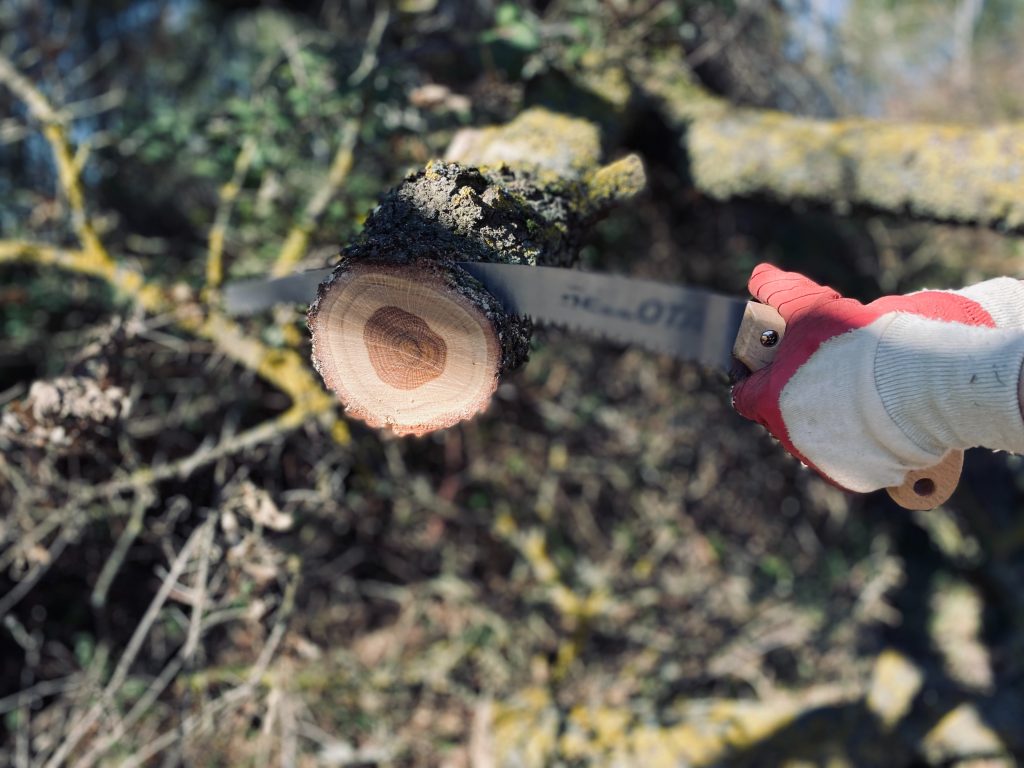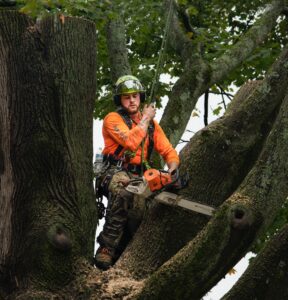Best Practices for Preventing Tree Damage From Heavy Snowfall
BEST PRACTICES FOR PREVENTING TREE DAMAGE FROM HEAVY SNOWFALL
Heavy snowfall can have significant impacts on trees, leading to various forms of damage that can harm tree health, structural integrity, and aesthetics. The weight of accumulated snow on tree branches and foliage can create stress and strain, potentially resulting in the following types of damage:

- Branch Breakage: The weight of snow can cause branches to bend and sag. If the snow load becomes excessive, it can lead to the snapping or breaking of branches. This not only reduces the tree’s overall canopy but also poses a safety hazard to people, property, and surrounding vegetation.
- Splitting of Crotches: Crotches, or the junctions where branches meet the trunk, are susceptible to splitting under heavy snow loads. This can lead to open wounds that expose the tree to diseases and decay, compromising its structural integrity.
- Crown Deformation: Snow accumulation on branches can alter the natural shape and structure of a tree’s crown. This deformation can be particularly concerning for trees that rely on an even distribution of foliage for proper growth and health.
- Uprooting and Instability: The weight of snow can destabilize trees by increasing their center of gravity and placing stress on the root system. In severe cases, this can lead to uprooting, especially for trees with shallow or compromised root systems.
- Damage to Bark and Trunk: As snow accumulates on tree trunks, it can create a damp environment conducive to fungal growth and disease. Additionally, falling snow and ice can physically damage the bark, creating entry points for pests and pathogens.
- Loss of Foliage: The weight of snow can cause leaves and needles to drop prematurely. This reduces the tree’s ability to perform photosynthesis and weakens its overall vitality.
- Canopy Thinning: If the snow load is not evenly distributed across the canopy, certain areas may experience heavier stress. This can lead to selective branch breakage and overall thinning of the tree’s canopy.
- Impact on Evergreens: Evergreen trees are particularly susceptible to snow-related damage due to their broad, flat branches that catch and hold snow. This can lead to bending, breakage, and deformation of branches.
- Snow Mold and Disease: Prolonged snow cover can create conditions favorable for the development of snow mold, a fungal disease that affects grass and groundcover beneath trees. Additionally, the moisture from melting snow can encourage various fungal and bacterial infections in trees.
- Pest Vulnerability: Trees stressed by heavy snowfall may become more susceptible to pest infestations, as their weakened state can make it difficult for them to fend off insect attacks.
Heavy snowfall can exert substantial stress on trees, resulting in branch breakage, structural damage, and overall decline in tree health. It’s important to take proactive measures to mitigate these risks and prevent snow-related damage to trees. Proper tree care practices, including pruning, support systems, and maintenance, can help reduce the potential impacts of heavy snow on trees.
Importance of Implementing Preventive Measures To Protect Trees
Implementing preventive measures to protect trees, especially in the face of potential threats like heavy snowfall, is crucial for maintaining the health, safety, and beauty of both individual trees and the larger ecosystem. These measures play a significant role in ensuring the longevity and vitality of trees while minimizing potential damage and hazards. Here’s why implementing preventive measures is important:

- Tree Health and Longevity: Preventive measures such as proper pruning, support systems, and regular inspections contribute to the overall health and longevity of trees. By addressing vulnerabilities and potential stressors, trees are better equipped to thrive and resist diseases and pests.
- Structural Integrity: Pruning for structural integrity and implementing support systems help trees withstand the stress of heavy snowfall or other environmental factors. Well-maintained trees are less likely to experience branch breakage, splitting, or uprooting.
- Safety for People and Property: Trees that are properly cared for and maintained are less likely to pose safety risks during extreme weather events. Preventive measures reduce the likelihood of falling branches, uprooting, or other tree-related hazards that could harm people, vehicles, and buildings.
- Aesthetic Value: Trees are essential components of landscapes, providing beauty, shade, and visual appeal. Implementing preventive measures ensures that trees maintain their natural form, aesthetics, and contribution to the overall environment.
- Ecosystem Health: Trees are integral parts of ecosystems, supporting wildlife habitats, promoting biodiversity, and enhancing air and water quality. By protecting trees from potential damage, we contribute to the overall health of the ecosystem.
- Cost Savings: Preventive measures are often more cost-effective than dealing with the aftermath of tree damage. Proper tree care can reduce the need for emergency tree removal, property repairs, and ongoing maintenance.
- Community Resilience: Trees in urban and suburban environments provide numerous benefits, including temperature regulation, energy savings, and improved mental well-being. Strengthening trees against threats helps communities remain resilient in the face of changing weather patterns.
- Environmental Stewardship: Implementing preventive measures aligns with responsible environmental stewardship. It showcases a commitment to preserving natural resources and ensuring that trees continue to provide ecological and social benefits.
- Education and Awareness: Taking proactive steps to protect trees sets a positive example within the community. It encourages others to value and care for trees, fostering a culture of responsible tree care and preservation.
- Future Preparedness: As climate patterns and weather events become more unpredictable, implementing preventive measures becomes increasingly important. Preparing trees for potential threats helps them adapt and thrive in changing conditions.
Implementing preventive measures to protect trees is an investment in their health, safety, and contribution to the environment. By addressing vulnerabilities and practicing responsible tree care, we ensure that trees continue to provide a wide range of benefits for generations to come. Choosing resilient tree species is a critical step in promoting healthy urban and natural landscapes. Resilient trees are those that can withstand and adapt to a variety of environmental stressors, including extreme weather conditions, pests, diseases, and soil variations. When selecting tree species for planting or landscaping, it’s important to consider their resilience to ensure long-term success and reduced maintenance requirements.
Here’s why choosing resilient tree species matters:
- Adaptation to Local Conditions: Resilient tree species are well-suited to the specific climate, soil, and environmental conditions of a particular area. They are more likely to thrive and resist stressors that might negatively affect other species.
- Climate Resilience: Resilient trees can tolerate a range of temperatures, precipitation levels, and weather extremes, making them better equipped to handle changing climate patterns and unexpected weather events.
- Reduced Maintenance Needs: Resilient trees typically require less care and maintenance because they are less susceptible to pests, diseases, and other stressors. This saves time, effort, and resources over the tree’s lifespan.
- Lower Risk of Pest and Disease Infestations: Resilient trees have natural defenses that make them less attractive to pests and less susceptible to disease. This reduces the need for chemical interventions and promotes a healthier ecosystem.
- Longevity and Stability: Resilient trees are more likely to live longer and maintain their structural integrity under various conditions. This reduces the risk of sudden tree failures and associated safety hazards.
- Biodiversity Enhancement: Planting a diverse range of resilient tree species contributes to biodiversity and ecosystem health. It creates a more resilient and stable ecosystem that can better support local wildlife.
- Environmental Benefits: Resilient trees contribute to environmental services such as air and water purification, carbon sequestration, and temperature regulation. Healthy trees enhance the overall quality of the environment.
- Aesthetic Value: Resilient trees can be chosen for their aesthetic qualities, ensuring that landscapes remain visually appealing while still benefiting from the trees’ adaptability.
- Sustainability and Long-Term Planning: Selecting resilient tree species aligns with sustainable landscape planning by reducing the need for frequent replacements and mitigating the impact of tree-related issues.
- Community Resilience: By choosing trees that can withstand various stressors, communities become more resilient to natural disasters, urban heat islands, and other challenges.
When choosing resilient tree species, it’s important to consult with local arborists, horticulturists, or extension services. They can provide valuable insights into species that are well-suited to the region’s conditions and can help achieve a balanced mix of trees for a thriving and resilient urban forest.
Pruning for Structural Integrity
Pruning for structural integrity is a vital aspect of responsible tree care aimed at developing strong, stable, and safe tree architecture. Proper pruning techniques ensure that a tree’s branches and overall structure can withstand environmental stressors, such as heavy snowfall, wind, and ice. Pruning for structural integrity involves selective branch removal and shaping to enhance the tree’s natural form and promote its long-term health and stability. Here’s how pruning for structural integrity works:
- Early Intervention: Pruning for structural integrity often begins when trees are young. Early pruning helps guide the tree’s growth by removing competing or poorly attached branches, promoting a single central leader, and preventing structural issues from developing as the tree matures.
- Targeted Branch Removal: Weak, co-dominant, and crossing branches are identified and selectively removed. These branches are particularly prone to breakage under stress. By removing them, the overall structure becomes more resilient.
- Proper Branch Attachment: Pruning encourages the development of branches with strong attachments to the main trunk. A strong attachment reduces the risk of branches splitting or breaking during storms or heavy snowfall.
- Crown Thinning: Selective removal of some inner branches helps increase light penetration and air circulation within the canopy. This reduces the risk of fungal growth and promotes even growth throughout the tree.
- Elevating Lower Branches: Elevating or raising lower branches creates clearance beneath the tree, reducing the likelihood of snow accumulating on the lower branches and causing breakage.
- Reduction of Overextended Branches: Branches that have grown too long or are disproportionately heavy can be pruned back to reduce their weight and prevent them from sagging under snow or ice loads.
- Balancing Canopy Weight: Pruning for structural integrity includes strategically thinning the canopy to ensure even weight distribution. This minimizes the risk of one side becoming disproportionately heavy during storms.
- Professional Arborist Expertise: Certified arborists have the expertise to identify potential structural issues and prune accordingly. They can assess a tree’s health, growth patterns, and potential risks to determine the most effective pruning approach.
- Regular Maintenance: Pruning for structural integrity is an ongoing process. Regular maintenance pruning ensures that the tree’s structure remains balanced and stable as it continues to grow.
- Preventing Sudden Failures: Pruning for structural integrity helps prevent sudden tree failures, reducing the risk of falling branches or uprooting during extreme weather events.
Overall, pruning for structural integrity is an investment in the long-term health, safety, and aesthetics of trees. By promoting strong branch attachments and balanced growth, trees are better prepared to withstand the challenges posed by heavy snowfall, wind, and other environmental stressors. Consulting with certified arborists and tree care professionals ensures that pruning is carried out in a way that supports the tree’s overall well-being.
About Murray, Utah
Murray is a city situated on the Wasatch Front in the core of Salt Lake Valley in the U.S. state of Utah. Named for territorial governor Eli Murray, it is the state's fourteenth largest city. According to the 2020 census, Murray had a population of 50,637. Murray shares borders with Taylorsville, Holladay, South Salt Lake and West Jordan, Utah. Once teeming with heavy industry, Murray's industrial sector now has little trace and has been replaced by major mercantile sectors. Known for its central location in Salt Lake County, Murray has been called the Hub of Salt Lake County. Unlike most of its neighboring communities, Murray operates its own police, fire, power, water, library, and parks and recreation departments and has its own school district. While maintaining many of its own services, Murray has one of the lowest city tax rates in the state.
Neighborhoods in Murray, Utah
Murray Oakes, Grant Park, Southwood Park, Murray Park, Murray Park Restrooms, Willow Pond Park, Neighborhood Veterinary Care
Things To Do in Murray, Utah
Bus Stops in Murray, Utah to Truco Services, Inc.
Bus Stop in Murray Central Station (Bay C) Murray, Utah to Truco Services, Inc.
Bus Stop in State St @ 4801 S Murray, Utah to Truco Services, Inc.
Bus Stop in Murray North Station Murray, Utah to Truco Services, Inc.
Bus Stop in State St @ 4949 S Murray, Utah to Truco Services, Inc.
Bus Stop in Murray Central Frontrunner/Trax Station Murray, Utah to Truco Services, Inc.
Bus Stop in Murray Blvd / Vine St (SB) Murray, Utah to Truco Services, Inc.
Bus Stop in State St @ 3925 S Murray, Utah to Truco Services, Inc.
Bus Stop in State St @ 4824 S Murray, Utah to Truco Services, Inc.
Bus Stop in State St @ 5223 S Murray, Utah to Truco Services, Inc.
Bus Stop in Murray Blvd / Allendale Dr (NB) Murray, Utah to Truco Services, Inc.
Bus Stop in Murray Blvd @ 5039 S Murray, Utah to Truco Services, Inc.
Bus Stop in State St @ 4721 S Murray, Utah to Truco Services, Inc.
Driving Directions in Murray, Utah to Truco Services, Inc.
Driving Directions from Woodruff Tree Trimming and Removal to 4640 Commerce Dr, Murray, UT 84107, USA
Driving Directions from Reliable Tree Care to 4640 Commerce Dr, Murray, UT 84107, USA
Driving Directions from Tree Pro-Tech to 4640 Commerce Dr, Murray, UT 84107, USA
Driving Directions from Prestige Tree And Landscape to 4640 Commerce Dr, Murray, UT 84107, USA
Driving Directions from Excellence Tree & Landscape to 4640 Commerce Dr, Murray, UT 84107, USA
Driving Directions from Amen Trees to 4640 Commerce Dr, Murray, UT 84107, USA
Driving Directions from Tim's Tree Care to 4640 Commerce Dr, Murray, UT 84107, USA
Driving Directions from Jordan Tree Service - Murray to 4640 Commerce Dr, Murray, UT 84107, USA
Driving Directions from Arbor Works to 4640 Commerce Dr, Murray, UT 84107, USA
Driving Directions from Diamond Tree Experts to 4640 Commerce Dr, Murray, UT 84107, USA
Driving Directions from Green Tree Arborist to 4640 Commerce Dr, Murray, UT 84107, USA
Driving Directions from TruCo Services to 4640 Commerce Dr, Murray, UT 84107, USA
Reviews for Truco Services, Inc. Murray, Utah
Emily Abercrombie
We had a great experience with TruCo! They were well priced, responsive and prompt. Michael was a pleasure to work with and gave us advice on which plants to put in where we took out our ugly old shrubs. I would highly recommend this company!!!
Michelle Turpin
TruCo Services gets 5 stars from us for customer service. We experienced a few issues with their services this last year and Rob Eccles in senior management, stepped in and immediately handled our issues. He was very committed to making sure they understood our expectations and would execute to make us happy.
Siobhan Billingsley
I work for a property management company and have the pleasure of working with Rob at a community in Sandy. He has been incredible to work with and always responds in a timely manner. He knows all the homeowners by name and address and is aware of all the "problem" areas when it comes to sprinklers. I never have to worry about following up with him because he always reaches out to provide me with an update. If you're looking to work with someone who takes pride in their job, is professional, and can solve the worst landscaping problems thrown your way, Rob is your guy. Thank you, Rob for all you do!
Jaime S.
We have used Truco at 2 of the complexes we manage, they have been great to work with. Good quality service, outstanding customer service with good communication. That's hard to find these days. I highly recommend them. Travis has been awesome to work with.
Jerusha Smart
We use TruCo for a majority of our properties and our home. While other landscaping companies we use come and go for various reasons like cost, communication issues, work performance, etc., TruCo is always consistent in price and work. Also, Rob is the best.

